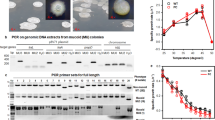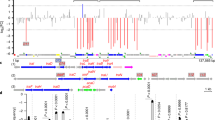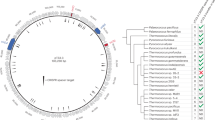Abstract
CONJUGATIVE plasmids of bacteria are extrachromosomal genetic elements able to bring about DNA transfer by conjugation. The best-studied system is that of F-like plasmids in Escherichia coli, where at least 12 genes are involved1. Expression of the transfer system in this case is subject to negative control2,3. We report here that the newly discovered conjugative activity of Ti plasmids is inducible by specific amino acid derivatives that are also the substrates for plasmid-coded catabolic enzymes. This finding further extends the analogy between the regulation of the lactose operon and of transfer functions.
This is a preview of subscription content, access via your institution
Access options
Subscribe to this journal
Receive 51 print issues and online access
$199.00 per year
only $3.90 per issue
Buy this article
- Purchase on Springer Link
- Instant access to full article PDF
Prices may be subject to local taxes which are calculated during checkout
Similar content being viewed by others
References
Helmuth, R. & Achtman, M. Nature 257, 652–656 (1975).
Finnegan, D. & Willetts, N. Molec. gen. Genet. 127, 307–316 (1973).
Willetts, N. J. molec. Biol. 112, 141–148 (1977).
Zaenen, I., Van Larebeke, N., Teuchy, H., Van Montagu, M. & Schell, J. J. molec. Biol. 86, 109–127 (1974).
Van Larebeke, N. et al. Nature 252, 169–170 (1974).
Van Larebeke, N. Nature 255, 742–743 (1975).
Watson, B., Currier, T. C., Gordon, M. P., Chilton, M. D. & Nester, E. W. J. Bact. 123, 255–264 (1975).
Currier, T. C. & Nester, E. W. J. Bact. 126, 157–165 (1976).
Schell, J. et al. in Molecular Biology of Plants (ed. Rubenstein, I.) (University Of Minnesota, Saint Paul, 1976).
Gordon, M. P. et al. in Molecular Biology of Plants (ed. Rubenstein, I.) (University of Minnesota, Saint Paul, 1976).
Sciaky, D., Montoya, A. & Chilton, M. D. Plasmid (submitted).
Kerr, A., Manigault, P. & Tempé, J. Nature 265, 560–561 (1977).
Genetello, C. et al. Nature 265, 561–563 (1977).
Petit, A., Delhaye, S., Tempé, J. & Morel, G. Physiol. Vég. 8, 205–213 (1970).
Goldmann, A. Annls Sci. Natur. Bot. Paris. 12ème série, 11, 223–310 (1971).
Kemp, J. D. Biochem. biophys. Res. Commun. 69, 816–822 (1976).
Bomhoff, G. H. et al. Molec. gen. Genet. 145, 177–181 (1976).
Petit, A. thesis, CNRS, Paris (1977).
Tourneur, J. thesis, CNRS, Paris (1975).
Nakazawa, T. & Yokota, T. J. Bact. 129, 39–46 (1977).
Author information
Authors and Affiliations
Rights and permissions
About this article
Cite this article
PETIT, A., TEMPE, J., KERR, A. et al. Substrate induction of conjugative activity of Agrobacterium tumefaciens Ti plasmids. Nature 271, 570–572 (1978). https://doi.org/10.1038/271570a0
Received:
Accepted:
Published:
Issue Date:
DOI: https://doi.org/10.1038/271570a0
This article is cited by
-
Evaluation of the interspecific competition within Agrobacterium spp. in the soil and rhizosphere of tomato and maize
Journal of Plant Pathology (2018)
-
Structural basis for high specificity of octopine binding in the plant pathogen Agrobacterium tumefaciens
Scientific Reports (2017)
-
Further studies on crown gall of stone fruit
Australasian Plant Pathology (2016)
-
Extrachromosomal, extraordinary and essential—the plasmids of the Roseobacter clade
Applied Microbiology and Biotechnology (2013)
-
Revisiting the host as a growth medium
Nature Reviews Microbiology (2008)
Comments
By submitting a comment you agree to abide by our Terms and Community Guidelines. If you find something abusive or that does not comply with our terms or guidelines please flag it as inappropriate.



